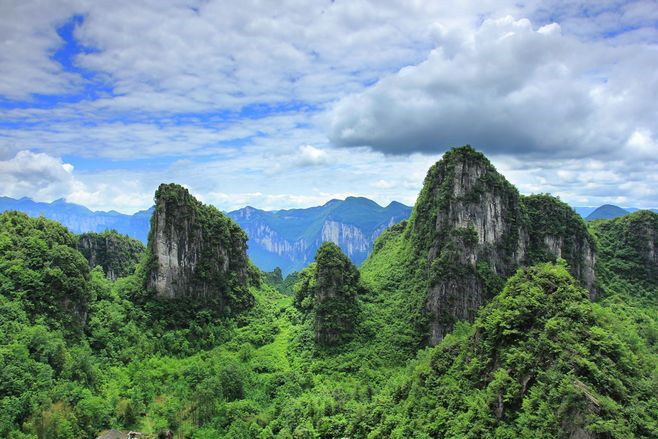The Value and Significance of Geological Heritage
Updated:2022-09-20 Source:Shennongjia National Park

The park is located at the northern margin of the Yangtze plate and the eastern section of the Qinling-Dabie orogenic belt, where the two blocks collide and merge. The two blocks are bounded by the Chengkou fault zone. The Shennongjia area is located in the eastern section of the Dabashan foreland structural belt, a recombination region of the Xuefengshan foreland and the Dabashan foreland, with the Wudang Uplift in the South Qinling Mountains in the north and the Jurassic Zigui Basin in the south.
Stratigraphic sections and their geological significance
The strata in the Shennongjia area are well developed, including the Mesoproterozoic, Neoproterozoic, Paleozoic, Mesozoic and Cenozoic Quaternary strata, in which the Neoproterozoic Qingbaikou System, Nanhua System, Sinian System and Lower Paleozoic outcrops are the best.
The Shennongjia area is one of the areas with the most well-preserved Late Precambrian strata in the world. The Shennongjia Group and the stratigraphic profiles of formations in the group are named after the name of this area. The Late Precambrian strata form one of the oldest folded basements in the Shennongjia area and even the northern margin of the Yangtze block and the entire southern China. It provides an important basis for establishing the stratigraphic correlation of this period in China and determining the upper Precambrian sequence, which is of great importance for the study of the Jinning orogeny, the formation and evolution of the Yangtze block and even the formation and breakup of the global Rodinia supercontinent.
The stromatolite-containing dolosone of Mesoproterozoic Shennongjia Group and paleontological clock
There are abundant well-preserved stromatolites in the Shennongjia area, which is one of the typical areas of Proterozoic stromatolites in southern China.
There are various types of Proterozoic stromatolites in Shennongjia area with clear laminas, which are ideal materials for paleontological clock research. A basic geological research can be carried out in a procedure as follow. First, by taking the gray value of the digital image of the sample as an index to measure the number and thickness of the lamina, the change of the chromaticity of the deposited lamina on the section of the sample is measured to obtain the number and thickness of the lamina. Then the spectral analysis method of lamina thickness data series is used to identify the multistage growth cycle of stromatolites, and then to determine the Proterozoic paleoclimate and astronomical cycle.
Early Neoproterozoic basic dike swarm and evolution of Rodinia supercontinent
There are basic volcanic rocks and basic rocks in the Precambrian strata in the Shennongjia area. The Mesoproterozoic basic volcanic rocks have metamorphosed. The protolith is tholeiitic volcanic rock, mainly continental tholeiitic basalt, with pores-almond-shaped structures. The Neoproterozoic basic rocks developed with the lithology of diabase and gabbro, which generally formed dikes. It may be the result of remelting from mantle sources previously metasomatized by subduction zone fluids in an extensional setting. It was formed around 770Ma, which is consistent with the breakup time of the Rodinia supercontinent, so it may be associated with the tectonic setting of the Rodinia supercontinent breakup. In addition, continental tholeiitic basalts are usually the products of the early rifting, representing an extensional tectonic setting, which further confirms that it is associated with the breakup of the Rodinia supercontinent.
Moraine of the Nantuo Formation in the Nanhua System and "Snowball Earth" event
The Neoproterozoic strata in Shennongjia are divided into the Qingbaikou System, the Nanhua System and the Sinian System from bottom to top. Among them, the Nanhua System is divided into two series and four formations. The lower series is the Liantuo Formation, and the upper series is divided into the Gucheng Formation, the Datangpo Formation and the Nantuo Formation from bottom to top. The Gucheng Formation and the Nantuo Formation are glacial horizons mainly composed of glacial rocks, and the Datangpo Formation belongs to the interglacial deposition. The distribution of glacial strata has obvious regional characteristics. Roughly bounded by the axis of the Shennongjia anticline, the Lower Sinian outcrop is complete in the west, and the strata from the Liantuo Formation to the Datangpo Formation are missing and the Nantuo Formation is directly overlaid on the Shennongjia Group with angular unconformity in the east.
Cap Dolostone of the Doushantuo Formation and Climate Warming Event
Cap carbonates refer to a relatively homogeneous thin-layered carbonate rock stratum mainly composed of microcrystalline calcite and dolomite directly overlying the Neoproterozoic moraine. The cap dolostone marks the end of the Neoproterozoic global glacial event - the "Snowball Earth" event. Its unique sedimentary structure and significant geochemical characteristics such as negative carbon isotope excursion allow scholars at home and abroad to restore the paleogeography of Neoproterozoic events at the end of the glacial period by exploring the genesis of cap dolostone.
The cap carbonates of the Doushantuo Formation in South China, which developed about 635Ma and overlie the moraine of the Nantuo Formation, is one of the best developed cap carbonates. The Sinian Doushantuo Formation in the Shennongjia UNESCO Global Geopark of Hubei is characterized by intact outcrop and continuous deposition. It is representative as it is close to the Three Gorges area where the typical Sinian section of China is located. In-depth study of it will help to clarify the characteristics and genesis of the late Neoproterozoic cap carbonates and the environmental changes at the end of the late Neoproterozoic glacial period.
Sinian-Cambrian black rock series and mineralization
"Black rock series", also known as "black shale", is a general term for a set of marine fine-grained sedimentary rocks characterized by rich organic matter, including various dark shale, silicalite, siltstone and a small amount of carbonatite. Black rock series is an important carrier of various useful elements such as Cu, Pb, Zn, Ni, Mo, V, U, Au, Ag, Pt and P, and a variety of rare and rare earth elements are also enriched in it. Many large and super-large deposits in the world are discovered in black rock series, which are known as "multi-element enrichment body" and have been paid attention to by the geologists for a long time.
A set of black rock series composed of silicalite, carbonaceous shale, carbonate and phosphorite was formed in the period from the Late Sinian to the Early Cambrian in Shennongjia, which is an important part of black rock series in this period in southern China. It is widely distributed, well developed and rich in fossils, which can be used for stratigraphic correlation with the contemporaneous black rock series in Asia, Europe, North America and Australia. The important "phosphorous formation" and other metallogenic events in the Shennongjia area are mostly associated with black rock series.
Thrust nappe structure in the northern margin of Shennongjia uplift and its geological significance
The tectonic position of Shennongjia area is very significant, which is the intersection of three arc-shaped tectonic belts (i.e., Daba Mountain in the north margin of the Yangtze plate, Xuefeng Mountain in eastern Sichuan and Dahong Mountain in western Hubei). From the Sinian section of the Lower Paleozoic, which was originally covered by the nappe and was exposed due to the incision of stream in the Shennongjia area, it can be preliminarily known that the scale of the Shennongjia nappe is much smaller than that of the Wudang nappe in the north. Moreover, the rock characteristics, structural style and deformation mechanism of the nappe structure are studied to further clarify the understanding of the geotectonic pattern of the area and establish the correlation with the surrounding important geological structural units, which is of great significance to the regional geological research on the northern margin of the Yangtze plate.
The Yangriwan fault in the Shennongjia area, which is the main slip fault of the Shennongjia nappe, consists of a series of southward high-angle thrust faults. Thrust faults tend to be more gentle and plough-shaped downwards. A series of imbricate secondary thrust faults developed inside the nappe, which incline to the hinterland of the orogenic belt and belong to a unified main slip plane. Along this main slip plane, the marine sediments of the Mesoproterozoic Luanshigou Formation in the region are thrust on the continental sediments of the Paleozoic. In addition, the region can be divided into two sub-zones with significant differences in both stratigraphic and structural characteristics by the Yangriwan fault.
Mesozoic-Cenozoic Uplift in the Shennongjia area
The Yanshanian movement from the Late Jurassic to the early Late Cretaceous (160Ma±-98.4Ma) caused continuous intracontinental orogeny in the Daba Mountains. Under the near S-N extrusion, the Shennongjia-Huangling area uplifted rapidly, and the surrounding caprock was strongly deformed, forming a series of east-west fold structures, which inherited and transformed the Indosinian fold-thrust structures. After the early Late Cretaceous, the uplift in the area was slow, the Jianghan Basin was dominated by sedimentation, and the Huangling Uplift was relatively stable. Since the Eocene-Oligocene (36.7Ma-28.4Ma), the Huangling area has been denuded and cooled again rapidly, reflecting the uplift and denudation since the Himalayan period.
Shennongjia is located at the superposition of the Dabashan arc structure and the Xuefengshan arc structure. The study of the uplift and denudation since the Mesozoic-Cenozoic is of great significance for understanding the tectonic evolution of the two major tectonic systems in the north and the south since the Mesozoic-Cenozoic.
Quaternary glacial landforms and their global climatic significance
Located in the mountainous area of western Hubei, Shennongjia consists of 6 peaks with an altitude of more than 3,000m. The mountainous area of western Hubei is located on the eastern edge of the second step of China's topography, in which the main peak of Shennongjia has the highest altitude. There are various types of glacial erosional and glacial depositional landforms, which are mainly found in Dajiuhu, Shennongding, and Qingtianpao of Muyu Town. From these glacial landforms, it can be concluded that there are three glacial periods and two periglacial periods. Glacier erosional landforms are clear, in which the glacier troughs and moraine-dammed lakes are best preserved. In addition, there are well-developed cirques, horn peaks and edge ridges, as well as corresponding glacial moraine, such as lateral moraine, bottom moraine and erratic.
Discovery of Pleistocene rhinoceros fossils in the Rhino Cave, Shennongjia and its paleontological significance
For a long time, most of the Pleistocene rhinoceros fossils in southern China have been classified into Rhinoceros sinensis. The rhinoceros fossils unearthed from the Rhino Cave, a Paleolithic site in Shennongjia, Hubei are no exception. However, the latest research suggests that the rhino fossils in the Rhino Cave in Shennongjia should be classified into Stephanorhinus kirchbergensis. This species was mainly found in northern China in the past, but it has also been found in the south of the Yangtze River in recent years. In terms of abundance and preservation, the rhinoceros fossils in the Rhino Cave in Shennongjia are undoubtedly the best among the fossil fauna in southern China. In particular, there is a basically intact juvenile skull, which is very rare. Although juvenile skulls have previously been found in Zhoukoudian, their fossil material is now missing. In addition, the Rhino Cave in Shennongjia is the highest quaternary rhinoceros fossil site found in the central and southern regions of China and is also a reliable fossil site of the southernmost distribution of Stephanorhinus kirchbergensis in China known so far. Therefore, this site is of great significance not only for the study of the rhinoceros fossil, but also for the study of the ecological environment evolution in the late Quaternary in the Shennongjia area.
Dajiuhu peat bog profile and its global climatic significance
The Dajiuhu peat bog, located at the westernmost end of the park, is a rare subalpine swamp in the mid-latitude subtropical region. In the inner side of the basin, there is a wide platform with a gentle slope at an altitude of 1,740-1,760m, which is composed of loess-like deposits in the middle to late Pleistocene. The deposits are yellow-brown loam in the upper part and brown-yellow loam in the lower part and contain gleying gray-white green strips with a thickness of more than 5m. The formation, development and paleo-environmental changes of swamp in subtropical karst area are recorded. Moreover, the sporopollen in peat records the evolution sequence of vegetation, climate and environment in Holocene. The occurrence and duration of abrupt events and the characteristics of monsoon transition were established through the study of various climatic and environmental substitute index such as organic carbon, nitrogen and organic carbon isotopes in this profile.
Copyright Shennongjia National Park
Address:36 Chulin Road, Muyu Town, Shennongjia Forestry District, Hubei Province 鄂ICP备18005077号-3
Address:36 Chulin Road, Muyu Town, Shennongjia Forestry District, Hubei Province 鄂ICP备18005077号-3
Email:2673990569@qq.com
Phone:0719-3453368
Phone:0719-3453368


TOP

